Flight mechanics is a well-covered topic in aerospace and mechanical engineering studies; the NASA has also published a valuable source of knowledge on aeronautics, but most of the literature is not targeted for a general audience. A brief overview of the parts of an airplane and the principles of flight is provided in this article for better understanding of the principles of flight.
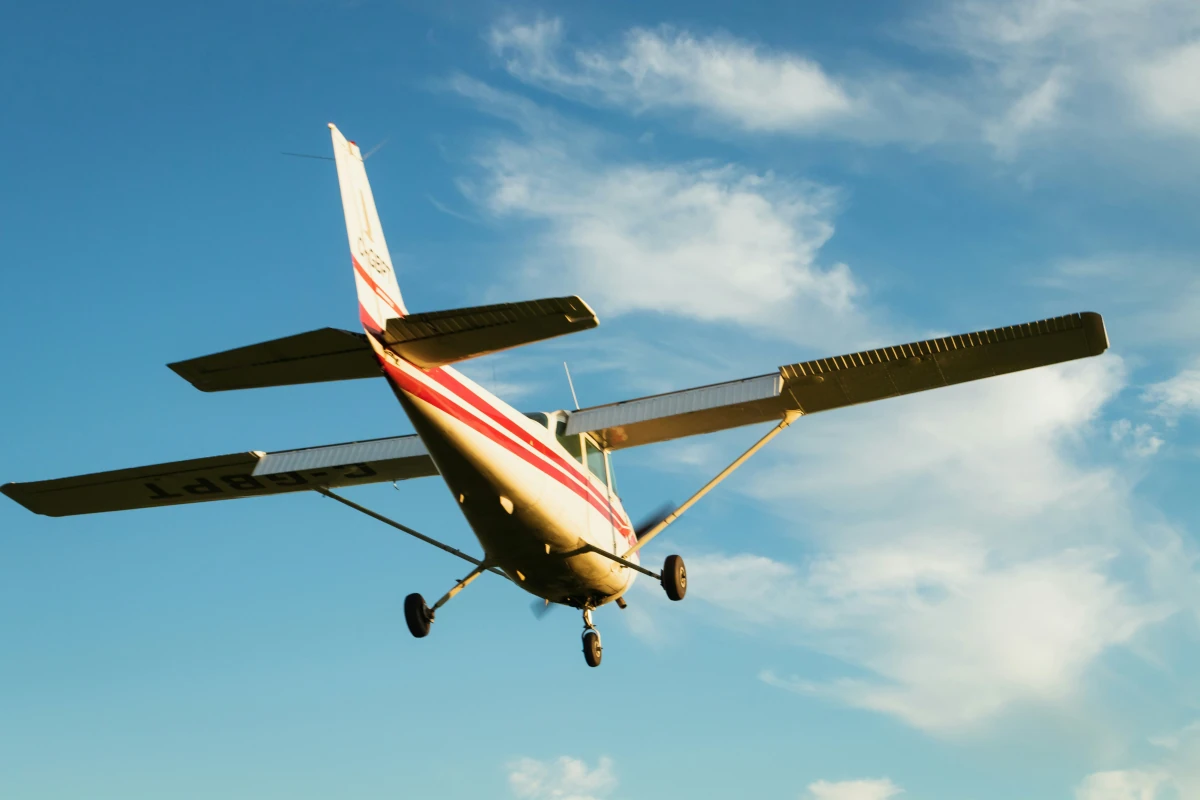
Main Parts of an Airplane
The airplanes have five major parts, including wings, fuselage, empennage, engines/propulsion, and landing gear. The flight performance is primarily dictated by the first three, and the fuselage is the main integrating element and houses most of the useful weight, such as payload and passenger. The wings are the major lifting component, and aircraft optimization is essentially performed through the wing optimization for a given flight condition and configuration. The empennage section comprises of two horizontal stabilizers and mostly a vertical stabilizer.
Wings
Wings are the most essential lift-generating elements on an aircraft. The wings should be able to lift the aircraft’s weight in different flight regimes (speed and altitude); however, the design is optimized for cruise speed. Lift generated on the wing is dependent on many design parameters, but the main contributors are the wing area and its cross-section. Wing area is set by the wing loading, which is a critical parameter for aircraft wing design.
The generation of lift on an airplane wing is largely dependent on the shape of its cross-section, also called the airfoil. What is an airfoil? To answer this question, a comprehensive answer is provided here. Airfoil is the section of the wing that generates lift by creating a low-pressure suction over the wing surface; the resultant pressure difference is the source of this force. The design of the airfoil is one of the most researched areas of wing optimization.
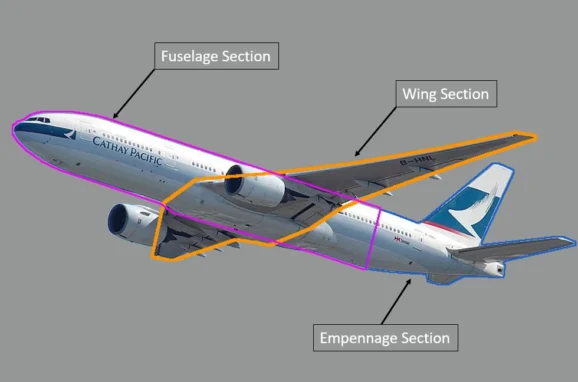
Fuselage
Fuselage is the usable compartment that is generally designed to have a sleeker, more aerodynamic shape. Slenderness ratio is the design parameter and is defined as the ratio of fuselage length to diameter (L/D); this ratio is selected to optimize the drag for a given usable volume. BWB configuration has eliminated the need for a separate fuselage by accommodating usable space into the wing design. This reduction in surface area or wetted area helps in reducing the skin friction drag, which has a noticeable impact at slow speeds but a significant contribution at high- speeds.
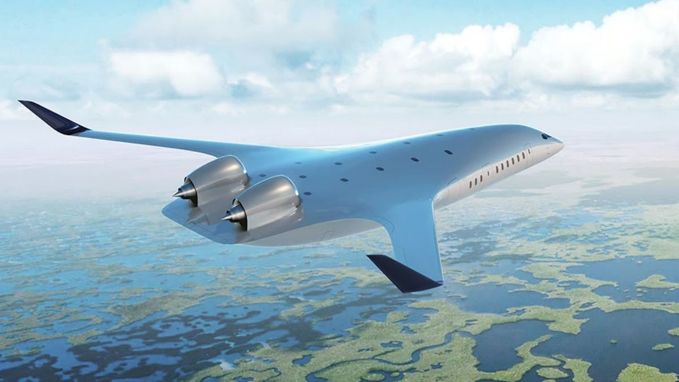
Empennage
A typical rear mounting configuration of horizontal and vertical stabilizers is called the empennage section. Stabilizers or tails, are placed at the aft section of the fuselage to maximize the moment arm, so that tail size would be minimized while generating the same effectiveness.
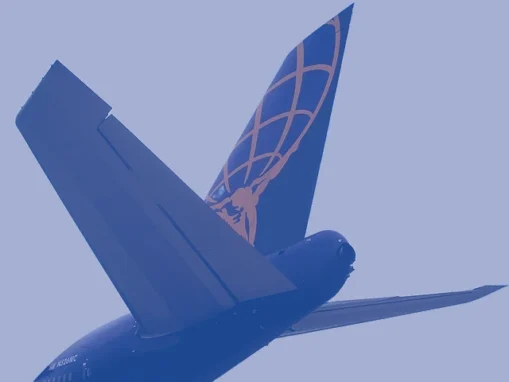
Horizontal Stabilizer
Practical aircraft design considerations require aircraft to be flightworthy throughout the center of gravity range. Aircraft are required to have a minimum surface area to reduce drag, such as in a flying wing or blended wing body (BWB) with no additional surface. However, practical variation of the center of gravity (CG) due to the distribution of passengers, luggage, fuel variation, and other payload configurations requires a properly-sized horizontal stabilizer to ensure proper stability and control. This typical configuration generates negative lift (putting a dent on the lift of the wing), as shown in the figure below:
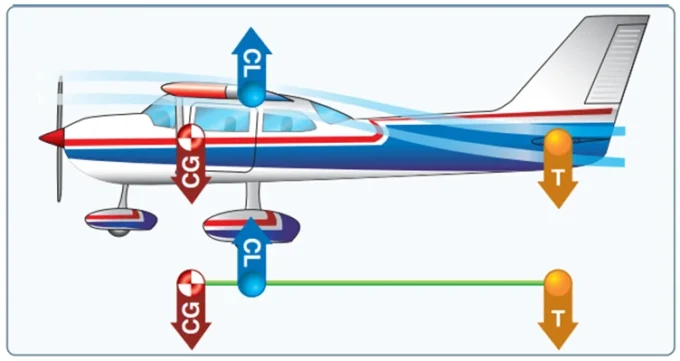
Another arrangement is a canard configuration, in which the tail is placed forward of the CG. In this arrangement, the tail is now lifting, thus increasing efficiency. However, a wide CG range may be difficult to manage in this configuration, and a restricted wing span (to manage aspect ratio) may be required to ensure static stability in all phases of flight. Therefore, canard configuration may not be an ideal choice to meet all design goals. But it is worth mentioning that for single-point design performance, this configuration has proven to be more fuel-efficient in terms of range.
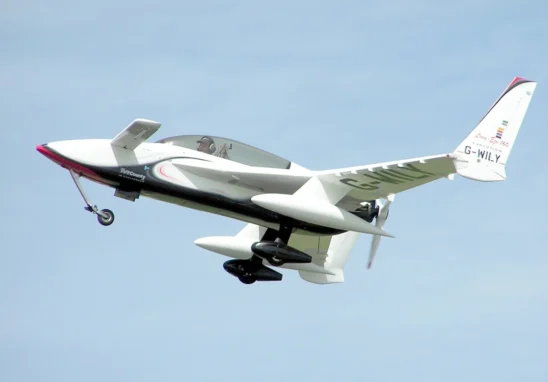
Vertical Stabilizer
A vertical tail is used to provide “Weather Cock” stability to an airplane so that it will not “side-slip.”. The effect of side-slip is undesirable in two ways: first, the wing is designed for longitudinal flow and does not perform well under side/lateral flow; second, side-flow generates loads that can alter the desired flight path of aircraft. Side-slip can also cause passenger discomfort on commercial flights.
Engine / Propulsion
The propulsion system is one of the key components of aircraft and choice of a specific propulsion system is dependent on the flight envelope. At lower airspeed and altitudes, engine driven propellers are simple and efficient systems. As the flight envelope expands, the amount of the power requirement increases significantly; in this regime, a turbo-fan engine is a more viable option, although it may not be as efficient. The turbojet engine has application at the extreme boundaries of the flight envelope. Generally, the aircraft design
Flight Envelope
The flight envelope defines the boundaries of an aircraft’s flyable speed and altitude. A flight envelope typically has a box shape with four corner points, defining a slow speed limit, a high speed limit, a maximum altitude and a sea level performance line. The flight envelope is a function of the aircraft design as well as the selected propulsion system. In general, speed lines are related to aircraft design and maximum altitude is dependent on propulsion.
Landing Gear
The main function of landing gears is to provide the ground handling of the aircraft; moreover, they are also responsible for bearing high loads during the transition at takeoff and landing. The landing gear configuration is mostly tricycle, and its derivative forms with three or multiple legs. Each landing gear may consist of strut and tire size, which is dictated by the ground reaction, or landing shock etc. The placement of landing gear is directly linked to the aircraft center of gravity and location of the wing.
Relative Flow Angles
Relative flow angles are important in the generation of forces on the aircraft. The two angles are the angle of attack (AOA) and the angle of side-slip (Beta). A detailed description of aerodynamic forces can be found here. Angle of attack is the longitudinal flow angle between the relative wind direction and airfoil cord-line and is the most sensitive parameter for generation of the lift

The angle of side-slip is the side-wise or lateral component of the flow. Side-slip is mostly an undesirable effect and therefore is minimized using the rudder control surface.
Flight Mechanics
Aircraft Orientations and Axes
A flying aircraft has six-degrees of freedom (6DoF) motion; therefore, it can move in three planes and rotate across three axes, which are pitch, roll and yaw. Angles are measured relative to the ground plane, also called the local geographic reference frame, where pitch rotation happens in the longitudinal plane and causes nose-up and nose-down movement of the aircraft. Roll axis rotation: the roll angle is measured in the lateral plane and wings move up and down relative to the ground. Finally, yaw is the out-of-plan lateral movement of the aircraft nose.

It is worth mentioning that aircraft orientations are relative to the ground and flow angles are relative to the incoming wind. For example, for a wing-level flight, the yaw angle and the angle of side-slip are measured in the yaw plane, but both are not same as the side-slip can occur without a yaw angle and vice versa. Similarly, the pitch angle and AOA are relatable in some cases but are essentially different parameters.
The Four Forces on Aircraft
The four forces of flight are lift, drag, thrust, and inertia/weight. Lift is produced to balance the inertial effect of weight (it will be more than 1G for maneuvering aircraft), and thrust is set to match the drag at the desired flying speed. Ideally, we want to minimize the drag while maintaining lift. Since drag is also a function of the lift being produced, a better measure of aerodynamic efficiency is the ratio of lift to drag (L/D). A designer tries to maximize this ratio in the flight envelope.

Steady or Trim Flight Condition
A steady-state or trim condition is state of an aircraft when the sum of all forces and moments is balanced so that its accelerations (linear and angular) are zero. An airplane has to fly at a certain AOA to maintain the lift while maintaining its flight path; additionally, for a steady-level condition, aircraft have a zero flight path angle. This will be in contrast to a steady climb condition in which aircraft maintain a non-zero flight path angle while maintaining the same amount of lift.
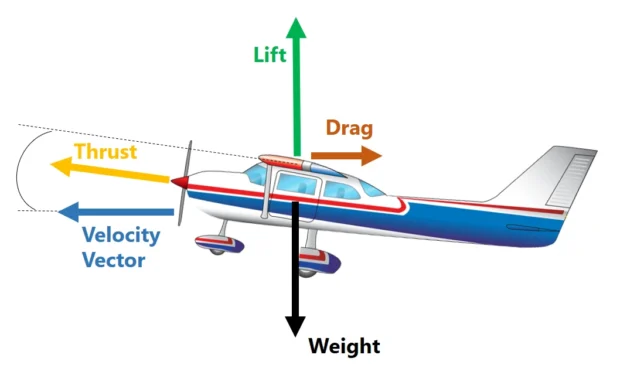
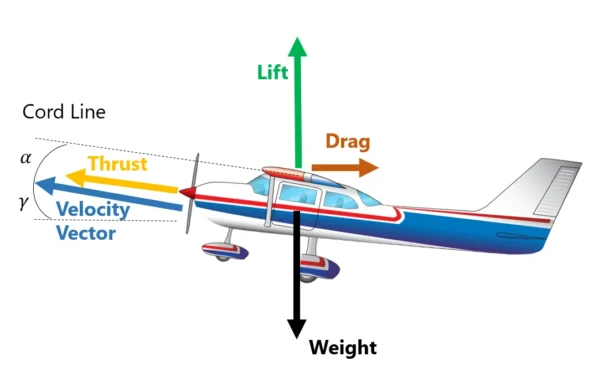
The energy required for flight is essentially supplied by the propulsion system to overcome the drag. Any “Excess Power” set by the pilot will either cause a speed rise or can be used to increase the altitude. Therefore, if the same airspeed is maintained by the pilot while in trim state, the rate of climb (vertical speed) gain is proportional to the excess power.

